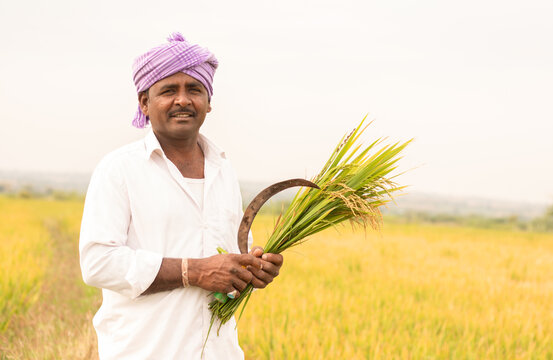Indian agriculture, the backbone of the country’s economy, faces a myriad of challenges that have a significant impact on the livelihoods of millions of farmers. From unpredictable weather patterns to lack of access to modern technology, Indian farmers grapple with several issues that hinder their productivity and economic prosperity. In this comprehensive article, we will delve into 11 major problems faced by Indian farmers in agriculture in India, shedding light on the complexities and difficulties they encounter in their daily lives, and provide detailed explanations for each challenge.
1. Fragmented Land Holdings
Problem: One of the foremost challenges faced by Indian farmers is the fragmentation of land holdings. The average size of landholdings in India has been decreasing over the years, leading to inefficient farming practices and reduced economies of scale.
Impact: Fragmented land holdings make it difficult for farmers to adopt modern agricultural practices and technologies, resulting in lower productivity and income. Additionally, small and fragmented land holdings often lead to land disputes and hinder the implementation of mechanized farming and efficient irrigation systems, further exacerbating the problem.
Solution: Encouraging land consolidation through land leasing reforms, promoting farmer producer organizations (FPOs) for collective farming, and providing incentives for cooperative farming can help address the issue of fragmented land holdings.
2. Dependence on Monsoons
Problem: Indian agriculture is heavily reliant on monsoons, making it vulnerable to the erratic and unpredictable nature of monsoon rains.
Impact: Inadequate or excess rainfall can lead to water scarcity or flooding, adversely affecting crop yields and farmer incomes. Moreover, climate change has intensified the unpredictability of monsoons, amplifying the challenges faced by farmers.
Solution: Investing in water conservation and management infrastructure such as rainwater harvesting, promoting drought-resistant crop varieties, and expanding the coverage of irrigation facilities can reduce the dependency on monsoons and mitigate the impact of erratic rainfall patterns.
3. Lack of Irrigation Facilities
Problem: A significant proportion of agricultural land in India is rain-fed, lacking access to proper irrigation facilities.
Impact: Dependence on rainfall limits the cropping patterns and reduces the productivity of the land, leading to income insecurity for farmers. Limited access to irrigation facilities also restricts the diversification of crops and agricultural practices, hindering sustainable agricultural development.
Solution: Expanding the coverage of micro-irrigation systems, promoting community-based irrigation projects, and implementing water-efficient agricultural practices can enhance irrigation facilities and reduce the dependency on rainfall.
4. Inadequate Access to Credit
Problem: Many small and marginal farmers in India struggle to access formal credit from financial institutions, forcing them to rely on informal sources of credit at high interest rates.
Impact: Inadequate access to credit hampers investment in modern farming techniques, machinery, and inputs, hindering agricultural growth. Moreover, the lack of credit options often pushes farmers towards indebtedness and financial vulnerability.
Solution: Strengthening rural credit delivery mechanisms, expanding the outreach of institutional credit, and promoting microfinance initiatives tailored to the needs of small farmers can improve access to credit and financial inclusion in rural areas.
5. High Input Costs
Problem: Indian farmers face soaring costs of agricultural inputs such as seeds, fertilizers, pesticides, and machinery.
Impact: High input costs reduce the profitability of farming, especially for small-scale farmers, leading to a vicious cycle of debt and poverty. The rising costs of inputs also deter farmers from adopting sustainable and organic farming practices due to financial constraints.
Solution: Providing subsidies on agricultural inputs, promoting the use of organic farming methods, and facilitating collective procurement and distribution of inputs can help alleviate the burden of high input costs on farmers.
6. Post-Harvest Losses
Problem: Inadequate infrastructure and technology for storage and transportation lead to substantial post-harvest losses of agricultural produce.
Impact: Farmers incur significant financial losses due to perishable produce and lack of proper storage facilities, affecting their incomes and livelihoods. Additionally, post-harvest losses contribute to food wastage and have broader implications for food security in the country.
Solution: Investing in cold storage facilities, promoting the use of refrigerated transport, and establishing efficient supply chain networks can minimize post-harvest losses and improve the income of farmers.
7. Market Instability
Problem: Indian farmers often face price volatility and lack of transparent market information, making them vulnerable to exploitation by middlemen.
Impact: Fluctuating prices and lack of market access lead to income uncertainty and financial distress for farmers. The absence of fair and transparent market practices hampers the income security of farmers and perpetuates their dependence on intermediaries.
Solution: Strengthening agricultural marketing infrastructure, establishing farmer producer organizations (FPOs) for collective bargaining, and promoting e-commerce platforms for direct farmer-consumer linkages can enhance market stability and reduce the influence of middlemen.
8. Lack of Access to Modern Technology
Problem: Many Indian farmers have limited access to modern agricultural technology and machinery, impeding productivity and efficiency.
Impact: The absence of modern technology hinders farm mechanization and limits the adoption of advanced farming practices, constraining agricultural output. Furthermore, inadequate technological know-how and training further hinder the integration of modern practices into traditional farming methods.
Solution: Providing subsidies for farm machinery and equipment, offering technical training and support for technology adoption, and fostering public-private partnerships for technology dissemination can bridge the gap in access to modern agricultural technology.
9. Land Degradation and Soil Health
Problem: Soil degradation and declining soil health due to chemical-intensive farming practices pose a significant threat to sustainable agriculture in India.
Impact: Degraded soil fertility reduces crop yields and necessitates increased chemical inputs, further exacerbating the problem. Soil erosion, salinization, and loss of organic matter adversely affect the long-term productivity and sustainability of agricultural land.
Solution: Promoting organic farming practices, implementing soil conservation measures, and incentivizing sustainable land management practices can help improve soil health and mitigate land degradation.
10. Lack of Agricultural Extension Services
Problem: Farmers often lack access to timely and relevant information on best agricultural practices and innovations.
Impact: The absence of extension services hinders the adoption of new techniques, resulting in suboptimal productivity and income levels. Effective extension services play a crucial role in disseminating knowledge, promoting sustainable practices, and addressing the specific needs of diverse farming communities.
Solution: Strengthening the agricultural extension system, leveraging digital technologies for knowledge dissemination, and establishing farmer training and demonstration centers can enhance the accessibility and effectiveness of agricultural extension services.
11. Policy Constraints and Inadequate Support
Problem: The agricultural sector in India grapples with policy constraints and inadequate government support, affecting farmers’ access to subsidies, insurance, and risk mitigation measures.
Impact: Limited policy support constrains the growth and development of the agricultural sector, perpetuating the challenges faced by Indian farmers. Inadequate investment in rural infrastructure, research, and development further impedes the modernization and resilience of the agricultural sector.
Solution: Reforming agricultural policies to provide comprehensive support for farmers, increasing public investment in agriculture, and promoting inclusive and sustainable agricultural development strategies can address the policy constraints and enhance the support available to farmers.
In conclusion, the challenges confronting Indian farmers in the agricultural sector are multifaceted and deeply entrenched. Addressing these issues requires a comprehensive approach encompassing policy reforms, investment in infrastructure, access to credit, technology dissemination, and market reforms. By acknowledging and tackling these challenges, India can strive towards a more sustainable and prosperous agricultural landscape, ensuring the well-being of its farming communities and the nation as a whole. The resolution of these challenges is pivotal to securing the future of Indian agriculture and enhancing the livelihoods of millions of farmers across the country. Efforts to address these challenges should be prioritized to ensure the long-term sustainability and resilience of Indian agriculture.


